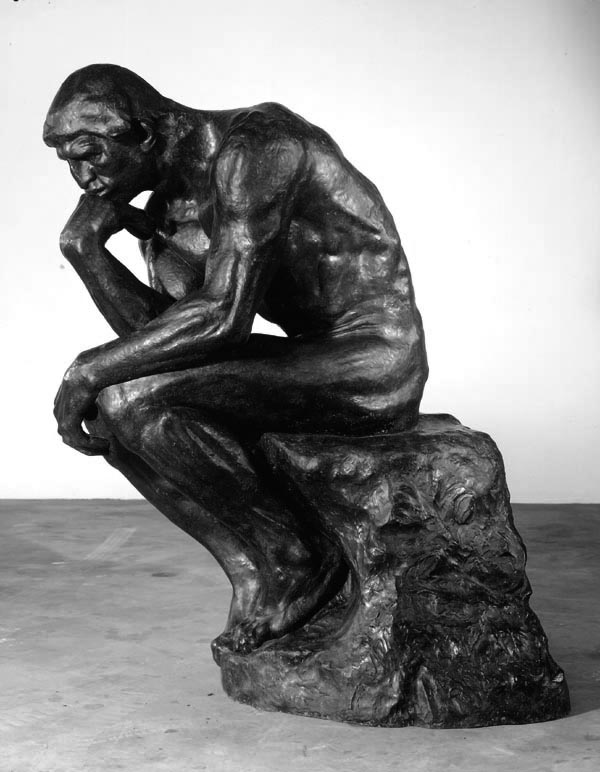 home
about
artists
exhibitions
press
contact
purchase
home
about
artists
exhibitions
press
contact
purchase |
|
AUGUSTE RODIN The Great Thinker Bronze, 183 cm (72 inches), conceived in 1903
Of all Rodin’s works, The Thinker was the most important to him. If The Age of Bronze summarized his youthful aspirations, The Thinker was Rodin’s emblem of his mature self. Rodin guarded the sculpture with unusual care: variations of the work were entrusted only to his most experienced associates and casters.* Placement of the enlargement of 1903-6, retitled The Great Thinker, was of critical concern. The first cast marked the entrance to the Pantheon, France’s final resting place for many of its heroes. Rodin also designated The Great Thinker as the monument to mark his and Rose Beuret’s tomb. Rodin began The Thinker, which was to be the dominant figure presiding over The Gates of Hell, with Dante, Michelangelo, and Carpeaux as his mentors.** He made some experiments with the seated figure, including a complete turning form with Michelangelesque modelling, and a series of small Titans in porcelain, which were made at Sèvres in 1878. Rodin also had the ruined, large-scale torso of his own Ugolino in his studio. From these preliminaries and a maquette made in 1880, The Thinker as we know it emerged by 1882. The hair still recalls the cap seen in portraits of Dante, while the lower portion retains echoes of Carpeaux’s Ugolino. However, there are few precedents for the pose, proportions, and power of The Thinker. By bringing the right elbow to the left knee, the hand to the chin, and by coiling the figure into a crouch, Rodin created his most powerful form. The pose is both dynamic and self-contained, absorbed in thought and capable of action, qualities that are enhanced when the figure is seen, as intended, from below, surveying the flood of bodies that made up The Gates. Despite its central position, The Thinker maintains the greatest degree of independence from The Gates. Rodin acknowledged that he began with the idea of making a figure of the Poet, or Dante. Once complete - as The Gates would never be - and freed from a narrative context, the Poet became The Thinker, a title the figure carried in its first and all subsequent exhibitions. Over the two decades that led up to its enlargement, The Thinker moved in the minds of its creator and his public from one of his most successful works to the one work that exemplified his greatest achievement as a sculptor. It was a form he kept intact: only the hand was extracted from the figure and issued as a separate object. * Until he gave the figure to the Alexis Rudier foundry in 1906, Rodin demanded that bronze versions, even of The Great Thinker, be produced by the arduous lost-wax method of casting. ** At the beginning of the nineteenth century, a number of artists had attempted to redefine the seated pose, which had been given an unsurpassable embodiment in Michelangelo’s painted and sculpted figures. The primary subject for experiments with the seated figure was Dante’s Ugolino. One of the most gruesome passages of the Inferno tells of Ugolino della Gherardesca who, walled up with his sons, cannibalized them to stay alive. The romantic extremes of the tale attracted many artists, most prominent among them Eugène Delacroix and Jean-Baptiste Carpeaux. Carpeaux’s Ugolino was the sensation of the 1863 Salon, where it won the grand prize. Carpeaux’s figure sits crouched, his elbows on his knees and hands in his mouth. Both the animated, loose technique and highly dramatic pose were unforgettable for Rodin. |
